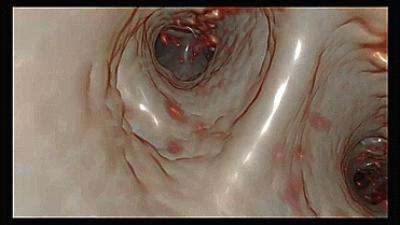Fantastic voyage into the human lung

A team of investigators at The Saban Research Institute of Children's Hospital Los Angeles has been awarded $4 million over five years by the National Heart Lung and Blood Institute (NHLBI) for LungMAP, an atlas of the developing human lung.
Borrowing from Hollywood blockbusters, the researchers are employing state-of-the-art animation technology in combination with advanced optical imaging and high-resolution x-ray imaging techniques. This novel technology will allow them to explore the composition and interaction of cells in the developing lung and to follow how the processes evolve over time.
The fetal lung is one of the last organs of the body to become fully functional. Development of the alveolus –tiny air sacs in the lungs where oxygen and carbon dioxide are exchanged– remains the critical factor in newborn viability as well as the origin of many childhood breathing disorders.
"Human alveolar development is currently a 'black box' because of the challenges of being able to see alveoli as they grow," said principal investigator David Warburton, OBE, DSc, MD, MMM, director of the Developmental Biology and Regenerative Medicine program at The Saban Research Institute. "Using newly optimized visualization technology we can now perform a 'virtual bronchoscopy' that begins in the bronchus and allows us to peer into the alveolus."
Alveolarization begins in humans at 20 to 24 weeks gestation and continues until at least age 7. To date, much of the information about this process has come from studying histological sections of lung. The LungMAP project will acquire information from the living, functioning lung. Using novel imaging technologies, the Saban researchers will create a high-resolution, four-dimensional map that catalogs the molecular, genetic and cellular events occurring during alveolar development in mice and humans.
By employing digital image processing techniques, high-resolution scans of real lung tissues can be converted into video. This approach enables observation of the overall topography of the airway as well as revealing information about the surfaces of individual cells. This video-based methodology allows researchers to easily visualize fine details of the lung, providing what co-investigator Rex Moats, PhD, calls a "Google street view" of addresses in the lung to be explored. The goal is for this map to be interactive in the same way that Google maps functions, Moats said.
"Our objectives are to radically transform our understanding of the formation of the gas exchange surface in the human lung, find new approaches to the care of premature infants, and to develop a better understanding of the numerous childhood- and adult-onset lung diseases," said Warburton. Co-investigators and collaborators on the project include Warburton, Moats, Scott Fraser, PhD, Wei Shi, MD, PhD, Rusty Lansford, PhD, Andreas Fouras, PhD, Barbara Driscoll, PhD and David Koos, PhD.
Provided by Children's Hospital Los Angeles